SUBFAMILY MYRMICINAE
| The Ants of Africa SUBFAMILY MYRMICINAE |
Diagnostic Features - Pedicel of two segments, postpetiole usually distinctly separated from the gaster. Pygidium not impressed. Eyes usually present. Ocelli absent. Antennae 4- to 12-segmented. Frontal carinae totally or partially covering the antennal insertions. Clypeus projecting back between the frontal carinae. Tibial spurs of middle and hindlegs simple or absent.
As has already been mentioned (Chapter 5) the separation into Tribes is in some confusion. For instance, there is the scheme used by Hölldobler & Wilson (1990). That list seems incomplete, however, and some earlier separation remained - that is, Tribes OCHETOMYRMICINI, MYRMECININI and CATAULACINI (as in Bolton, 1973, and Bolton, 1994). Bolton (1994) had the Tribe FORMICOXENINI as including the Cardiocondylini and Leptothoracini. Bolton (1981a) noted that the Tribe MERANOPLINI (with Calyptomyrmex, Dicroaspsis from Central Africa, and Meranoplus) had been dissolved (citing work on myrmicine stings by Kugler, 1978) and that his earlier (Bolton, 1972) inclusion of Ankylomyrma in the Tribe was wrong. The question, however, was left unanswered - the Tribe went but no indication of any other placement was given and he wrote that Ankylomyrma had no affinities with the other three genera. For present simplicity, I have kept MERANOPLINI for Meranoplus and Ankylomyrma, as has Bolton (1995).
Bernard (1952) wrote how the classical studies by Mayr, Emery and Forel were in need of revision, especially as knowledge of males and larvae were throwing up useful characters. Now, the situation is much improved with many excellent generic and subgeneric revisions stemming from the work of Bolton, as follows:
Pyramica Roger, 1862a: 251. Type species: Pyramica
gundlachi Roger, by monotypy. Pyramica junior synonym of Strumigenys:
Roger, 1863b: 40; Dalla Torre, 1893: 145; Bingham, 1903: 147. Revived
from synonymy as subgenus of Strumigenys: Brown, W.L. 1948e:
110. Junior synonym of Strumigenys: Brown, W.L. & Wilson,
1959b: 281; Brown, W.L. 1960c: 37. Revived from synonymy: Bolton, 1999.
J. Nat. Hist., 33, 1667. To further complicate, or
arguably simplify, the Dacetine situation, Baroni Urbani & De
Andrade (2007: 101) postulated that Strumigenys
should be the senior synonym of (Afrotropical genera only given here): Cladarogenys, Epitritus, Glamyromyrmex, Miccostruma, Pyramica, Serrastruma, Smithistruma and Trichoscapa. I note this but, as my
key objective is the ease of identification, have retained the old
genera with two main pages for Strumigenys and Pyramica, the latter having a
key to separate the remainder.
It still remains, however, that the two genera of greatest economic and ecological importance - Crematogaster and Pheidole - are in overwhelming need of revision.
Note: [December 2007] Fernando Fernandez has kindly sent me a copy of his revisionary study of Carebara. I had missed this because the title denotes it as being on "American species" and gives no indication of his synonymization of the genera Oligomyrmex, Paedalgus and Afroxydris. For the present, because of the work involved I am retaining the African members linked from the key below and the linked genus and species pages in the pre-Fernandez genera.
Note: Using a DNA analysis, Ward et al. (2014: 5) claim to have demonstrated that Ankylomyrma is "neither in the Myrmicinae nor even a member of the more inclusive formicoid clade - rather it is a poneroid ant, sister to the genus Tatuidris (Agroecomyrmecinae)".
Ward et al. (2014: 10) resurrected the Genera Syllophopsis and Trichomyrmex from synonymy with Monomorium. These are keyed from Monomorium.
Illustrated key to Genera known from sub-Saharan Africa (text derived in greater part from Bolton, 1994) - comments relate only to genera from the subregion.
| 1 | 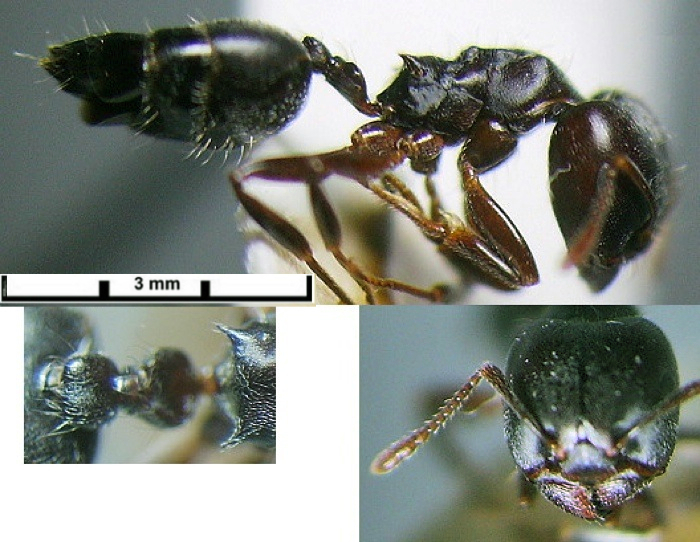 Postpetiole
articulated on dorsal surface of first gastral segment; the gaster in
dorsal view roughly heart-shaped and capable of reflexion over the
alitrunk. Petiole dorsoventrally flattened and without a node. Many
species, with wholly inadequate classification. Some (subspecies Atopogyne
polymorphic, size up to 7-8 mm), most monomorphic and small (2-3 mm).
Mostly arboreal. Postpetiole
articulated on dorsal surface of first gastral segment; the gaster in
dorsal view roughly heart-shaped and capable of reflexion over the
alitrunk. Petiole dorsoventrally flattened and without a node. Many
species, with wholly inadequate classification. Some (subspecies Atopogyne
polymorphic, size up to 7-8 mm), most monomorphic and small (2-3 mm).
Mostly arboreal. |
Genus Crematogaster |
| -- | Postpetiole articulated on anterior face of first gastral segment; the gaster in dorsal view not roughly heart-shaped, not capable of reflexion over the alitrunk. Petiole not dorsoventrally flattened, with a node of some form. | 2 |
| 2 | Antenna never terminating in a conspicuous, 2-segmented club. Either apical plus 2 preapical segments of antenna enlarged and forming a conspicuous, 3-segmented club, or less commonly the club with more than 3. Rarely the funiculus filiform and without a developed apical club. | 17 |
| -- |  Apical
and preapical antennal segments much larger than preceding funicular
segments and forming a conspicuous and usually very distinctive
2-segmented club. Apical
and preapical antennal segments much larger than preceding funicular
segments and forming a conspicuous and usually very distinctive
2-segmented club. |
3 |
| - | Antennae with two-segmented club | - |
| 3 | 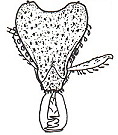 Mandibles
elongate and linear, produced into narrow projecting blades, each one
of which is much longer than broad. Mandibles never triangular or
subtriangular, never serially multidentate or denticulate. All small to
minute, largest ca 4 mm. Mandibles
elongate and linear, produced into narrow projecting blades, each one
of which is much longer than broad. Mandibles never triangular or
subtriangular, never serially multidentate or denticulate. All small to
minute, largest ca 4 mm. |
4 |
| -- | Mandibles triangular or subtriangular, not produced into narrow projecting blades, apical (masticatory) margins usually serially multidentate or denticulate, but teeth sometimes reduced. | 7 |
| 4 | 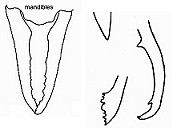 Apex of each
mandibular blade either with a single, long
tooth at the dorsal apex subtended by a series of minute denticles, or
with a series of minute denticles only; always lacking an apical fork
of 2 or 3 spiniform teeth. Apex of each
mandibular blade either with a single, long
tooth at the dorsal apex subtended by a series of minute denticles, or
with a series of minute denticles only; always lacking an apical fork
of 2 or 3 spiniform teeth. |
Pyramica (subgenera Epitritus and Cladarogenys) |
| -- | Apex of each mandibular blade armed with a fork of 2 or 3 spiniform teeth set in a more or less vertical series, with or without intercalary teeth between the spiniform fork teeth (see next couplet). | 5 |
| 5 | 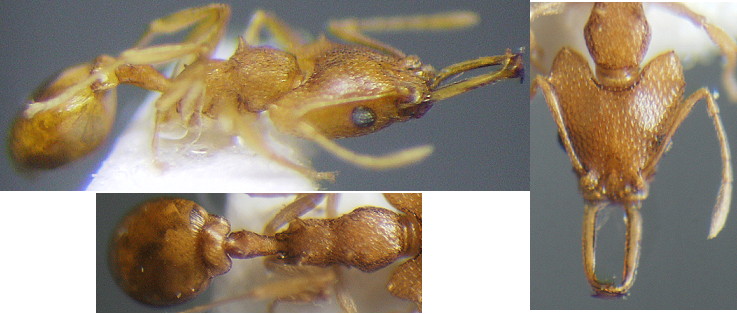 Apical fork of mandible
with 3 spiniform teeth; blade of
mandible without preapical teeth. Maxillary palp 3-segmented. Antennal
scrobes absent, the eyes dorsolateral. Petiole node with a pair of
teeth or short spines, postpetiole with lateral lamellate appendages. Apical fork of mandible
with 3 spiniform teeth; blade of
mandible without preapical teeth. Maxillary palp 3-segmented. Antennal
scrobes absent, the eyes dorsolateral. Petiole node with a pair of
teeth or short spines, postpetiole with lateral lamellate appendages. |
Microdaceton |
| -- | 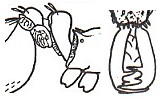 Apical
fork of mandible with 2 spiniform teeth; blade of mandible usually with
preapical teeth. Maxillary palp 1-segmented. Antennal scrobes present,
the eyes ventrolateral. Petiole node unarmed, postpetiole with
spongiform appendages. Apical
fork of mandible with 2 spiniform teeth; blade of mandible usually with
preapical teeth. Maxillary palp 1-segmented. Antennal scrobes present,
the eyes ventrolateral. Petiole node unarmed, postpetiole with
spongiform appendages. |
6 |
| 6 | 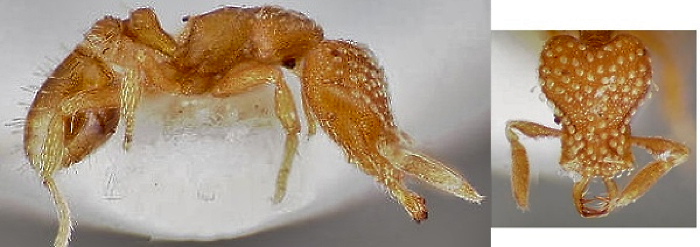 Antenna
with 4 segments; one tramp species, TL 1.7-1.9 mm. Antenna
with 4 segments; one tramp species, TL 1.7-1.9 mm. |
Quadristruma |
| -- |  Antenna
with 6 segments; all small to minute, TL rarely > 2 mm; most from
leaf litter, a couple from soil/litter nests in tree crevices. Antenna
with 6 segments; all small to minute, TL rarely > 2 mm; most from
leaf litter, a couple from soil/litter nests in tree crevices. |
Strumigenys |
| Mandibles triangular or subtriangular | - | |
| 7 | Antenna with 4-6 segments | 8 |
| -- | Antenna with 8-12 segments | 9 |
| 8 | 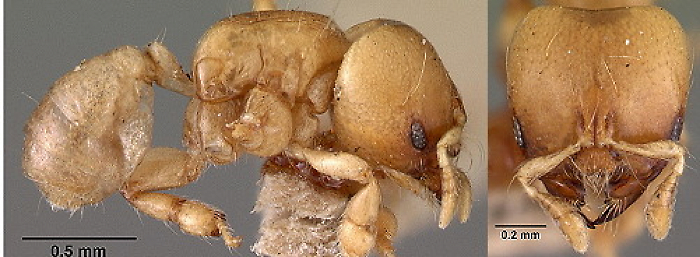 Spongiform
or lamellate appendages absent from petiole and postpetiole. Frontal
lobes confluent, situated centrally and high on dorsum of head.
Mandible with 4 teeth. Antennal scrobes absent. Anterior coxae much
smaller than the massively developed middle and hind coxae. Small
(2-3.5 mm) species; all specially adapted to living in tunnels under
bark on living trees. Spongiform
or lamellate appendages absent from petiole and postpetiole. Frontal
lobes confluent, situated centrally and high on dorsum of head.
Mandible with 4 teeth. Antennal scrobes absent. Anterior coxae much
smaller than the massively developed middle and hind coxae. Small
(2-3.5 mm) species; all specially adapted to living in tunnels under
bark on living trees. |
Melissotarsus |
| -- | 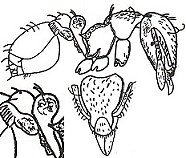 Spongiform
or lamellate appendages present on petiole, postpetiole, or both.
Frontal lobes widely separated, situated laterally on anterior half of
head. Mandible with more than 4 teeth. Antennal scrobes present.
Anterior coxae as large as or larger than the middle and hind coxae.
All small to minute, largest ca 4 mm Spongiform
or lamellate appendages present on petiole, postpetiole, or both.
Frontal lobes widely separated, situated laterally on anterior half of
head. Mandible with more than 4 teeth. Antennal scrobes present.
Anterior coxae as large as or larger than the middle and hind coxae.
All small to minute, largest ca 4 mm |
Pyramica (subgenera Glamyromyrmex, Serrastruma, Smithistruma and Trichoscapa) |
| 9 | Antenna with 12 segments. | 10 |
| -- | Antenna with 8-11 segments. | 11 |
| 10 | 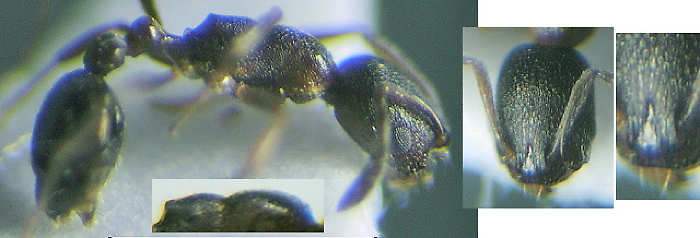 Palp
formula 5,3. Frontal lobes separated and median portion of clypeus
broadly inserted between them. Lateral portions of clypeus flattened
and prominent, fused to the raised projecting median portion of the
clypeus to form a shelf, which projects forward over the mandibles.
Propodeal lobes low and rounded, not connected to propodeal spines
(when present) by broad projecting lamellae. All small to minute,
largest ca 3 mm. Palp
formula 5,3. Frontal lobes separated and median portion of clypeus
broadly inserted between them. Lateral portions of clypeus flattened
and prominent, fused to the raised projecting median portion of the
clypeus to form a shelf, which projects forward over the mandibles.
Propodeal lobes low and rounded, not connected to propodeal spines
(when present) by broad projecting lamellae. All small to minute,
largest ca 3 mm. |
Cardiocondyla |
| -- | 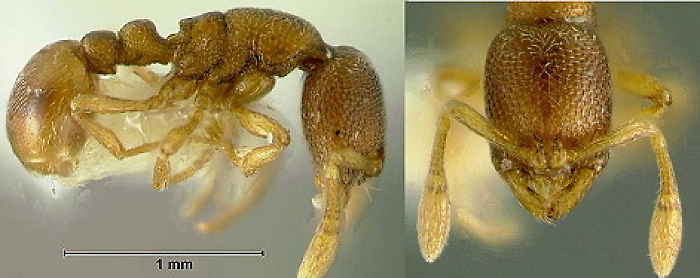 Palp
formula 2,2. Frontal lobes closely approximated and median portion of
clypeus reduced to an extremely narrow strip between them. Lateral
portions of clypeus not prominent, not fused to median portion, and not
forming a shelf; instead median portion of clypeus sharply raised
centrally and in the form of a narrow longitudinal ridge. Propodeal
lobes large and prominent, connected to propodeal spines by broad,
conspicuous lamellae. Very small species, ca 2 mm. Palp
formula 2,2. Frontal lobes closely approximated and median portion of
clypeus reduced to an extremely narrow strip between them. Lateral
portions of clypeus not prominent, not fused to median portion, and not
forming a shelf; instead median portion of clypeus sharply raised
centrally and in the form of a narrow longitudinal ridge. Propodeal
lobes large and prominent, connected to propodeal spines by broad,
conspicuous lamellae. Very small species, ca 2 mm. |
Baracidris |
| 11 |  Anterior
clypeal margin with a single, long, anteriorly projecting median seta
at the midpoint of the margin. Clypeus strongly longitudinally
bicarinate. Propodeum always unarmed and rounded. Antennae
10-segmented. Variably polymorphic; small to minute - currently (2008)
there appears to be a separation of genus members into Solenopsis
(the larger polymorphic species) and the smaller monomorphic Diplorhoptrum Anterior
clypeal margin with a single, long, anteriorly projecting median seta
at the midpoint of the margin. Clypeus strongly longitudinally
bicarinate. Propodeum always unarmed and rounded. Antennae
10-segmented. Variably polymorphic; small to minute - currently (2008)
there appears to be a separation of genus members into Solenopsis
(the larger polymorphic species) and the smaller monomorphic Diplorhoptrum |
Solenopsis |
| -- | Anterior clypeal margin lacking a single, median seta; instead a pair of setae usually straddle the midpoint of the margin. Propodeum sometimes unarmed and rounded but usually with spines or teeth, or sharply angulate. Antenna with 8-11 segments | 12 |
| . | Now [November 2007] all regarded by Fernandez (2004) as in the single genus Carebara, except for the unresolved Pheidologeton | . |
| 12 | Antenna with 8 or 9 segments. | 13 |
| -- | Antenna with 10 or 11 segments. | 15 |
| 13 | 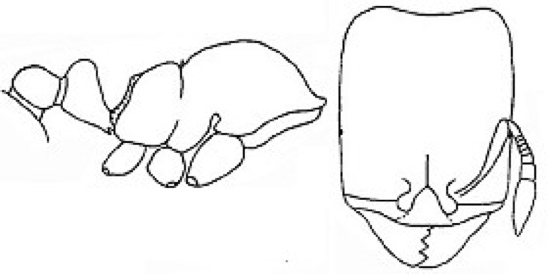 Propodeum
bidentate, bispinose, or sharply angulate in profile. Worker caste
dimorphic, without intermediates; all minute TL no more than 2 mm;
nesting in dead wood on ground or in leaf litter. Propodeum
bidentate, bispinose, or sharply angulate in profile. Worker caste
dimorphic, without intermediates; all minute TL no more than 2 mm;
nesting in dead wood on ground or in leaf litter. |
Oligomyrmex (subgenus Oligomyrmex) |
| -- | Propodeum unarmed. Worker caste monomorphic. | 14 |
| 14 | 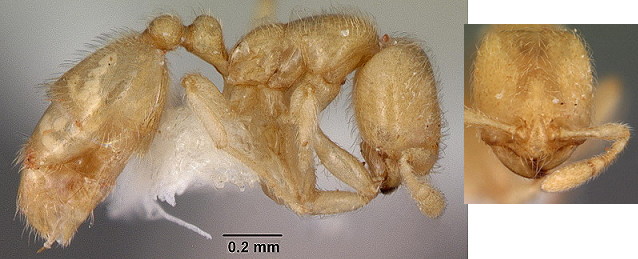 Eyes
absent. Mandible with 5 or 6 teeth. Promesonotum not marginate
laterally. All possibly nesting in termite hills and all small TL
1.6-2.5 mm. Eyes
absent. Mandible with 5 or 6 teeth. Promesonotum not marginate
laterally. All possibly nesting in termite hills and all small TL
1.6-2.5 mm. |
Carebara |
| -- | 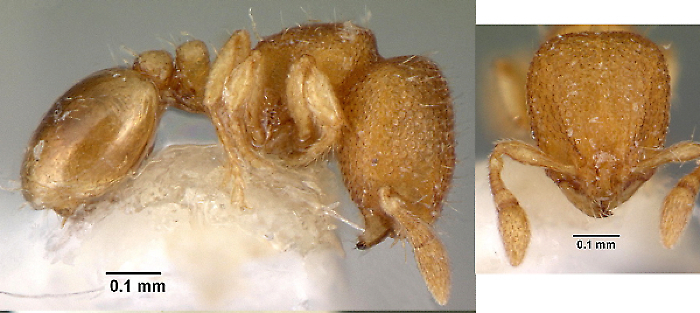 Eyes
present. Mandible with 4 or 5 teeth. Promesonotum marginate laterally.
Minute, TL 1-1.5 mm, species; leaf litter dwelling and foraging Eyes
present. Mandible with 4 or 5 teeth. Promesonotum marginate laterally.
Minute, TL 1-1.5 mm, species; leaf litter dwelling and foraging |
Paedalgus |
| 15 |
 Mandible
with 2 teeth apically, the teeth followed by an elongate, very oblique,
edentate margin, which ends at the acute basal angle. With mandibles at
full closure there is a distinct gap between their inner borders and
the anterior clypeal margin. Minute, ca TL 1.5 mm, monotypic, known
only from two specimens, soil/deep leaf litter nesting. Mandible
with 2 teeth apically, the teeth followed by an elongate, very oblique,
edentate margin, which ends at the acute basal angle. With mandibles at
full closure there is a distinct gap between their inner borders and
the anterior clypeal margin. Minute, ca TL 1.5 mm, monotypic, known
only from two specimens, soil/deep leaf litter nesting. |
Afroxyidris |
| -- | Mandible with 4 or more teeth, which occupy the entire apical margin; without an elongate, oblique, edentate margin behind the two apical teeth. With mandibles at full closure without a gap between their inner borders and the anterior clypeal margin. | 16 |
| 16 | 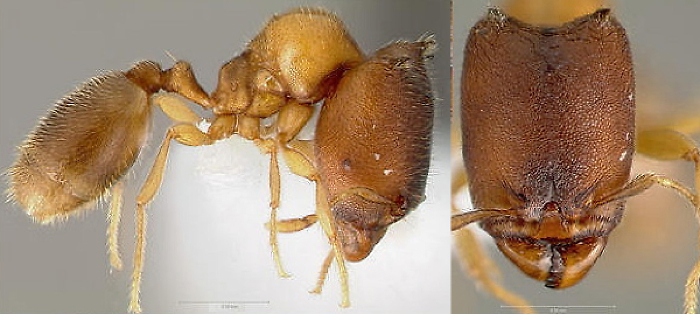 Clypeus
longitudinally bicarinate on median portion.
Worker caste dimorphic, without intermediates; perhaps twelve species
in genus; all minute TL no more than 2 mm; nesting in dead wood on
ground or in leaf litter. Clypeus
longitudinally bicarinate on median portion.
Worker caste dimorphic, without intermediates; perhaps twelve species
in genus; all minute TL no more than 2 mm; nesting in dead wood on
ground or in leaf litter. |
Oligomyrmex (subgenera Aneleus, 11-segmented antennae; Aeromyrma, 10-segmented antennae) |
| -- | 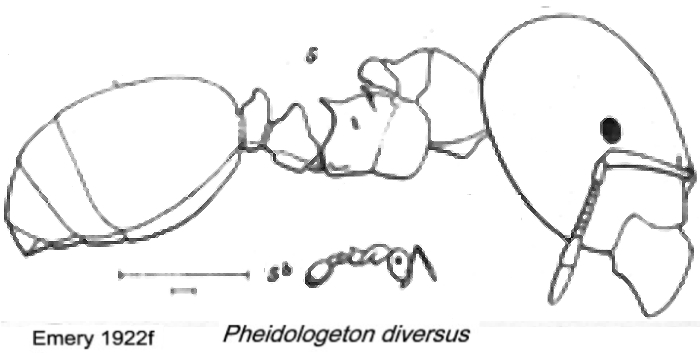 Clypeus not bicarinate on
median portion. Worker caste
polymorphic with a graded series of intermediates connecting minor to
major workers. Best known species (P. diversus) probably not
from Africa; three species from this region known only from queens or
males. Clypeus not bicarinate on
median portion. Worker caste
polymorphic with a graded series of intermediates connecting minor to
major workers. Best known species (P. diversus) probably not
from Africa; three species from this region known only from queens or
males. |
Pheidologeton |
| Funiculus with three-segmented club or filiform | - | |
| 17 | 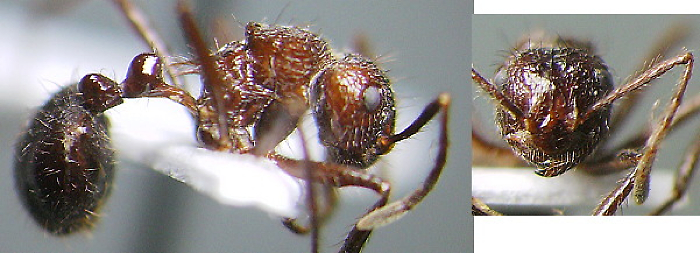 Antenna
with 7 segments; propodeum bispinose; gaster typically held so that
apex pointing forward under the legs; weakly dimorphic; one small
slender species (TL ca 4 mm) is arboreal; others small (TL 5 mm), most
quite large (TL 7-10 mm) and soil dwelling, may forage on trees. Antenna
with 7 segments; propodeum bispinose; gaster typically held so that
apex pointing forward under the legs; weakly dimorphic; one small
slender species (TL ca 4 mm) is arboreal; others small (TL 5 mm), most
quite large (TL 7-10 mm) and soil dwelling, may forage on trees. |
Myrmicaria |
| -- |
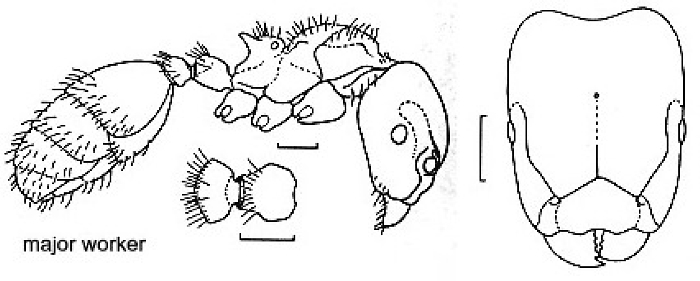 Antennae 8-segmented
without a differentiated club; major no more than 7.0 mm; petiole
without spines Antennae 8-segmented
without a differentiated club; major no more than 7.0 mm; petiole
without spines |
Atopomyrmex (part) |
| -- | Antenna with 9-12 segments. | 18 |
| 18 | 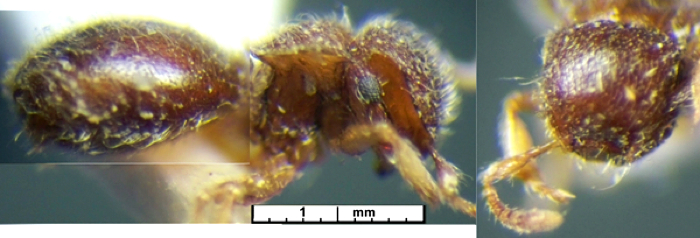 Antenna
with 9 segments. Petiole sessile, without an anterior peduncle.
Pronotum and mesonotum fused into a laterally projecting shield, which
overhangs the sides of the alitrunk on each side and sometimes also
overhangs the propodeum posteriorly. All small (TL ca 2.5-3.5); soil
nesting and surface foraging, will climb trees to tend aphids. Antenna
with 9 segments. Petiole sessile, without an anterior peduncle.
Pronotum and mesonotum fused into a laterally projecting shield, which
overhangs the sides of the alitrunk on each side and sometimes also
overhangs the propodeum posteriorly. All small (TL ca 2.5-3.5); soil
nesting and surface foraging, will climb trees to tend aphids. |
Meranoplus |
| -- | Antenna with 10-12 segments. Petiole usually with an elongate anterior peduncle; if not then the pronotum and mesonotum do not form a shield overhanging sides of the alitrunk. | 19 |
| 19 | 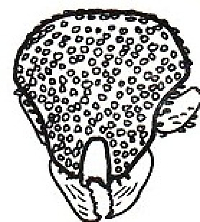 Median
portion of clypeus vertical, with a conspicuous anteriorly projecting
bilobed appendage above (the clypeal fork), which projects over the
mandibles from about the same level as the frontal lobes. Median
portion of clypeus vertical, with a conspicuous anteriorly projecting
bilobed appendage above (the clypeal fork), which projects over the
mandibles from about the same level as the frontal lobes. |
20 |
| -- | Median portion of clypeus not vertical, without a bilobed appendage projecting over the mandibles from about the same level as the frontal lobes. | 21 |
| 20 | 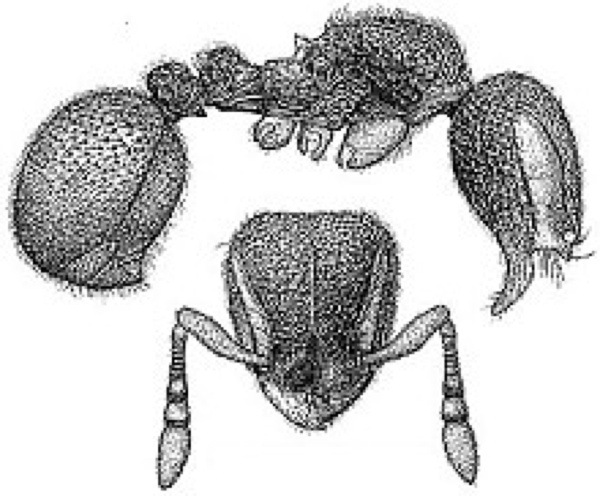 Antenna
with 11 segments. Peduncle of petiole short and very thick in profile.
All body setae simple, without bizarre pilosity. TL about 3 mm. Antenna
with 11 segments. Peduncle of petiole short and very thick in profile.
All body setae simple, without bizarre pilosity. TL about 3 mm. |
Dicroaspis |
| -- | 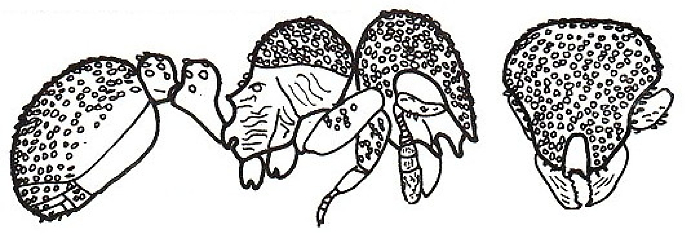 Antenna
with 12 segments. Peduncle of petiole elongate and narrow in profile.
Body setae bizarre; either spatulate, squamate, clavate, star-shaped,
or very short, thick, and stubbly with abruptly tapered points. All
small, TL 2-4 mm; from leaf litter, nesting in rotten wood. Antenna
with 12 segments. Peduncle of petiole elongate and narrow in profile.
Body setae bizarre; either spatulate, squamate, clavate, star-shaped,
or very short, thick, and stubbly with abruptly tapered points. All
small, TL 2-4 mm; from leaf litter, nesting in rotten wood. |
Calyptomyrmex |
| 21 | 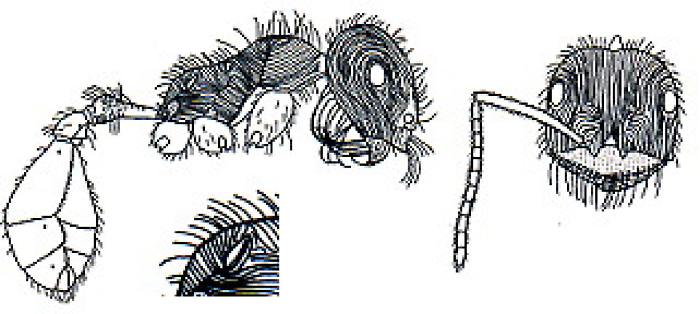 Propodeal
spiracle long and narrow, its orifice slit-like. Mesothoracic spiracles
opening on dorsum of alitrunk. Mandible with at least the third tooth
from the apex, and usually the third and fourth teeth, double-ranked.
From dry desert to semi-desert. Propodeal
spiracle long and narrow, its orifice slit-like. Mesothoracic spiracles
opening on dorsum of alitrunk. Mandible with at least the third tooth
from the apex, and usually the third and fourth teeth, double-ranked.
From dry desert to semi-desert. |
Ocymyrmex (South and East Africa) |
| -- | Propodeal spiracle circular to subcircular, very rarely oval but never long and narrow with a slit-like orifice. Mesothoracic spiracles concealed by a pronotal flap on the sides of the alitrunk. Without double-ranked mandibular teeth. | 22 |
| 22 | Antenna with 11 or 12 segments. | 24 |
| -- | Antenna with 10 segments. | 23 |
| - | Antenna with 10 segments | - |
| 23 | 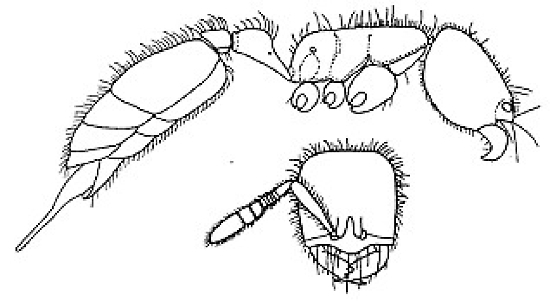 Entirely
lacking eyes, minute TL < 2.0 mm; postpetiole articulated high on
the first gastral tergite; single unnamed species from Tanzania (image
is of a south Asian species) Entirely
lacking eyes, minute TL < 2.0 mm; postpetiole articulated high on
the first gastral tergite; single unnamed species from Tanzania (image
is of a south Asian species) |
Anillomyrma |
| -- | 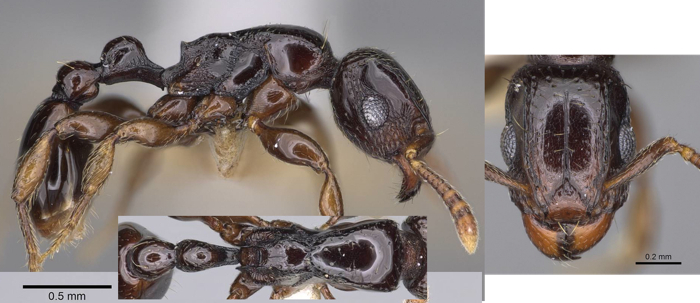 Sting shaft with an
apicodorsal, triangular to pennant-shaped lamelliform appendage.
Propodeal spiracle low on side and behind midlength, abutting the
metapleural gland, widely separated from the dorsal outline in profile.
Petiole with a long anterior peduncle. Palp formula 4,3. Small, TL ca 3
mm. Sting shaft with an
apicodorsal, triangular to pennant-shaped lamelliform appendage.
Propodeal spiracle low on side and behind midlength, abutting the
metapleural gland, widely separated from the dorsal outline in profile.
Petiole with a long anterior peduncle. Palp formula 4,3. Small, TL ca 3
mm. |
Decamorium |
| -- | Antenna with 11 or 12 segments | 25 |
| 24 | Antenna with 12 segments | 34 |
| -- | Antenna with 11 segments | 25 |
| -- | Antenna with 11 segments | 25 |
| 25 | 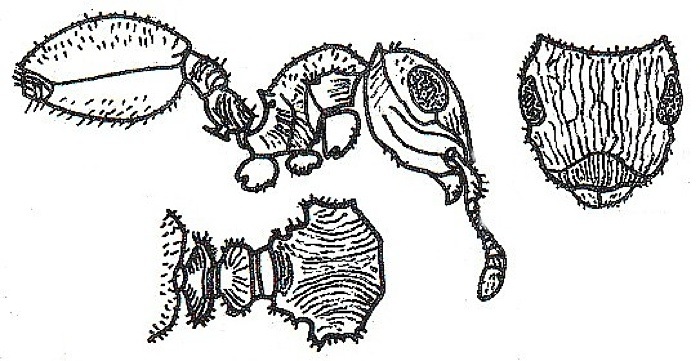 Antennal scrobes present,
running below the eyes. Dorsum of gaster consisting entirely of the
expanded first tergite, the remaining tergites visible in profile below
the posterior margin of the first. Almost all arboreal; size ranging
from quite large, TL 5-7 mm, foraging and homoptera tending species, to
small specialist stem inhabiters, TL ca 3 mm. Antennal scrobes present,
running below the eyes. Dorsum of gaster consisting entirely of the
expanded first tergite, the remaining tergites visible in profile below
the posterior margin of the first. Almost all arboreal; size ranging
from quite large, TL 5-7 mm, foraging and homoptera tending species, to
small specialist stem inhabiters, TL ca 3 mm. |
Cataulacus |
| -- | Antennal scrobes either absent or present but running above the eyes. Dorsum of gaster not consisting entirely of the first tergite, the remaining tergites continuing the line of the first and visible in dorsal view. | 26 |
| 26 | 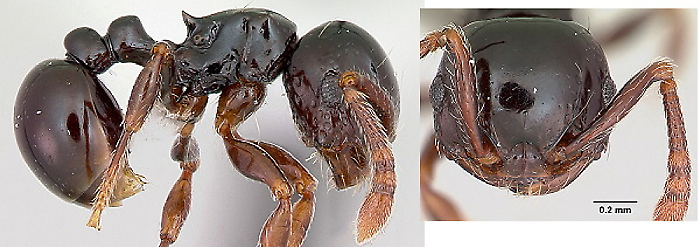 Frontal lobes vestigial or
absent so that the antennal articulations are exposed and the depressed
area containing the antennal sockets clearly visible. Anterior clypeal
margin armed with denticles. Small, TL ca 3 mm; from forest and open
woodland, nesting in dead wood. Frontal lobes vestigial or
absent so that the antennal articulations are exposed and the depressed
area containing the antennal sockets clearly visible. Anterior clypeal
margin armed with denticles. Small, TL ca 3 mm; from forest and open
woodland, nesting in dead wood. |
Pristomyrmex |
| -- | Frontal lobes present, covering most or all of the antennal articulations, the antennal sockets not fully visible in dorsal view. Anterior clypeal margin unarmed or with a pair of small teeth. | 27 |
| 27 | 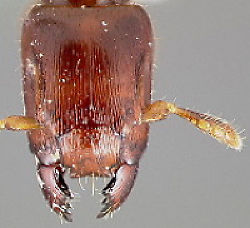 Eyes (may be very
small and difficult to see) located
behind midlength of sides of head. Median portion of clypeus raised and
produced forward as a large, shield-like lobe projecting strongly over
the mandibles. Tibiae and basitarsi of middle and hind legs terminating
in a number of peg-like, stout spines Eyes (may be very
small and difficult to see) located
behind midlength of sides of head. Median portion of clypeus raised and
produced forward as a large, shield-like lobe projecting strongly over
the mandibles. Tibiae and basitarsi of middle and hind legs terminating
in a number of peg-like, stout spines |
Metapone |
| -- | Eyes located at or in front of the midlength of the sides of the head, or sometimes absent. Median portion of clypeus not produced forward as a large, shield-like lobe projecting strongly over the mandibles. Tibiae and basitarsi of middle and hind legs not terminating in peg-like, stout spines | 28 |
| 28 | Maxillary palp with 1 or 2 segments. Propodeum rounded to angulate, never armed with differentiated teeth or spines. Anterior clypeal margin with a single median seta. Antennal scrobes always absent and mandible with only 4 teeth. | 29 |
| -- | Maxillary palp with 3-5 segments. Propodeum bidentate or bispinose. Anterior clypeal margin without a single median seta, usually with a pair of setae that straddle the midline. Antennal scrobes frequently, but not always, present and mandible usually with 5 or more teeth. | 31 |
| 29 | 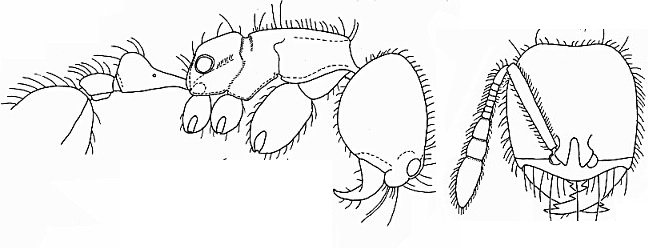 Eyes absent. Propodeal spiracle
enormously enlarged, circular. Frontal lobes closely approximated and
median portion of clypeus narrow posteriorly between the lobes.
Monotypic, small, TL 2.1-2.5 mm. Eyes absent. Propodeal spiracle
enormously enlarged, circular. Frontal lobes closely approximated and
median portion of clypeus narrow posteriorly between the lobes.
Monotypic, small, TL 2.1-2.5 mm. |
Bondroitia |
| -- | 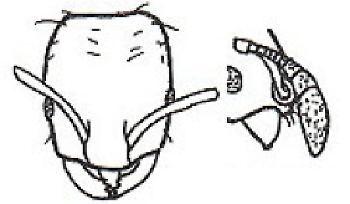 Eyes present.
Propodeal spiracle small, usually
pinhole-like. Frontal lobes widely separated and median portion of
clypeus broad posteriorly between the lobes. Eyes present.
Propodeal spiracle small, usually
pinhole-like. Frontal lobes widely separated and median portion of
clypeus broad posteriorly between the lobes. |
30 |
| 30 | 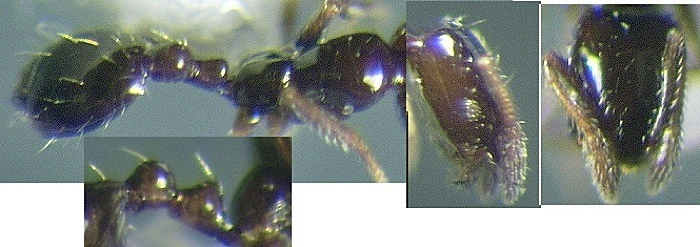 Median portion of clypeus
distinctly raised, strongly to weakly longitudinally bicarinate.
Postpetiole node less voluminous than petiole node in profile and
narrowly attached to the gaster. Seven species with 11-segmented
antennae; all minute TL < 2 mm; possibly all arboreal. Median portion of clypeus
distinctly raised, strongly to weakly longitudinally bicarinate.
Postpetiole node less voluminous than petiole node in profile and
narrowly attached to the gaster. Seven species with 11-segmented
antennae; all minute TL < 2 mm; possibly all arboreal. |
Monomorium (part) |
| -- | 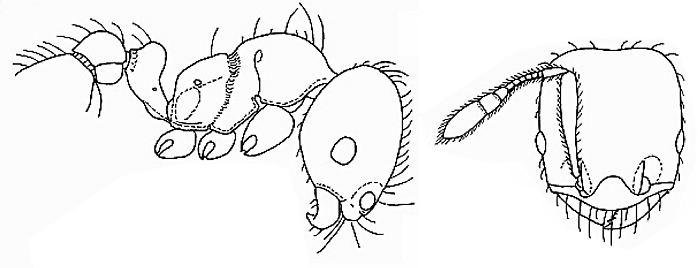 Median
portion of clypeus evenly transversely convex, not distinctly raised
nor longitudinally bicarinate. Postpetiole node much more voluminous
than petiole node in profile and very broadly attached to gaster
(monotypic - South Africa) Median
portion of clypeus evenly transversely convex, not distinctly raised
nor longitudinally bicarinate. Postpetiole node much more voluminous
than petiole node in profile and very broadly attached to gaster
(monotypic - South Africa) |
Diplomorium |
| 31 | Mandible with 4 or 5 teeth or denticles in total, the basal tooth generally concealed by the anterior clypeal margin. Sting acute apically, not terminating in a lamellate, spatulate, or dentiform appendage. | 32 |
| -- | Mandible with 6 or more teeth or denticles, usually with at least 7. Sting terminating in an apical or apicodorsal lamellate, spatulate, or dentiform appendage. | 33 |
| 32 | 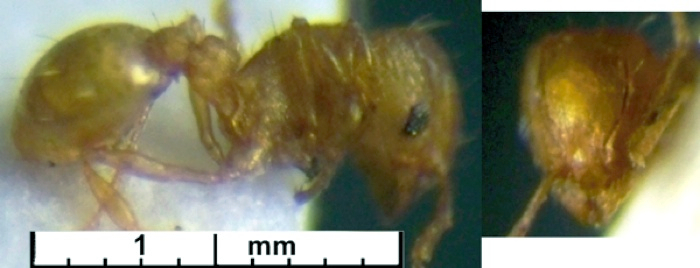 Frontal carinae and
antennal scrobes present. Palp formula 3,2. Petiole with an anterior
peduncle. Nodes of petiole and postpetiole without spines or tubercles.
One pantropical tramp species (ex-South America); minute, TL < 2 mm. Frontal carinae and
antennal scrobes present. Palp formula 3,2. Petiole with an anterior
peduncle. Nodes of petiole and postpetiole without spines or tubercles.
One pantropical tramp species (ex-South America); minute, TL < 2 mm. |
Wasmannia |
| -- | 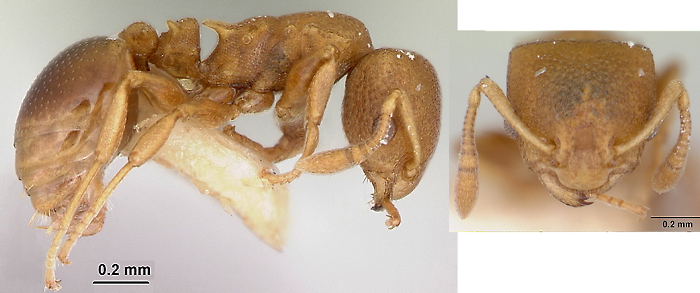 Frontal carinae and
antennal scrobes absent. Palp formula 5,3. Petiole sessile, without an
anterior peduncle. Nodes of petiole and postpetiole with spines or
tubercles. One species with 11-segmented antennae; minute, TL < 2
mm; inhabits plant stems. Frontal carinae and
antennal scrobes absent. Palp formula 5,3. Petiole sessile, without an
anterior peduncle. Nodes of petiole and postpetiole with spines or
tubercles. One species with 11-segmented antennae; minute, TL < 2
mm; inhabits plant stems. |
Nesomyrmex (part) |
| 33 | 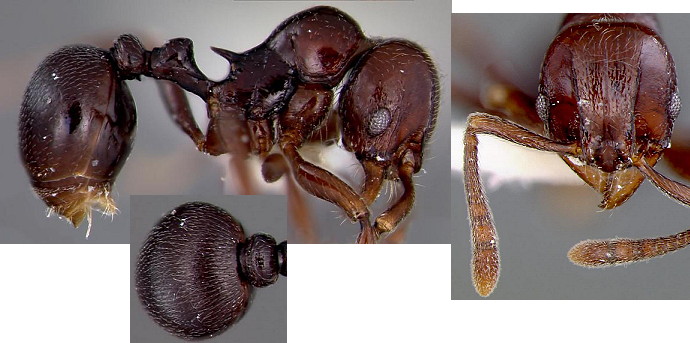 Lateral portions of clypeus
not raised into a narrow ridge or wall in front of the antennal
insertions. Median portion of clypeus narrow and bicarinate, narrowly
inserted between frontal lobes. Mandible armed with 10-14 teeth which
decrease in size from apex to base. Promesonotum in profile with a
swollen and dome-like outline. Small, TL ca 4 mm; from forest leaf
litter. Lateral portions of clypeus
not raised into a narrow ridge or wall in front of the antennal
insertions. Median portion of clypeus narrow and bicarinate, narrowly
inserted between frontal lobes. Mandible armed with 10-14 teeth which
decrease in size from apex to base. Promesonotum in profile with a
swollen and dome-like outline. Small, TL ca 4 mm; from forest leaf
litter. |
Cyphoidris |
| -- | 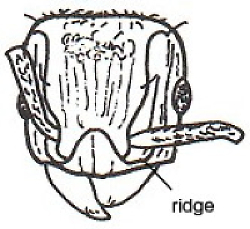 Lateral
portions of clypeus raised into a narrow ridge or wall in front of the
antennal insertions. Median portion of clypeus broad, not bicarinate,
broadly inserted between frontal lobes. Mandible armed with 2 or 3
enlarged teeth apically, followed by a row of at least 4 smaller
denticles, sometimes more. Promesonotum in profile without a swollen
and dome-like outline. Lateral
portions of clypeus raised into a narrow ridge or wall in front of the
antennal insertions. Median portion of clypeus broad, not bicarinate,
broadly inserted between frontal lobes. Mandible armed with 2 or 3
enlarged teeth apically, followed by a row of at least 4 smaller
denticles, sometimes more. Promesonotum in profile without a swollen
and dome-like outline. |
34 |
| 34 |  Palp formula 3,2. Head
heart-shaped in full-face view.
Median portion of clypeus with a prominent, arcuate anterior margin,
which overlaps the basal angle of the mandible. Antennal scrobes always
absent. Ventral margin of petiole keel-like. Eyes behind midlength of
sides of head. Small, TL ca 3 mm, species with eleven segmented
antennae, soil-inhabiting. Palp formula 3,2. Head
heart-shaped in full-face view.
Median portion of clypeus with a prominent, arcuate anterior margin,
which overlaps the basal angle of the mandible. Antennal scrobes always
absent. Ventral margin of petiole keel-like. Eyes behind midlength of
sides of head. Small, TL ca 3 mm, species with eleven segmented
antennae, soil-inhabiting. |
Rhoptromyrmex (part) |
| -- | 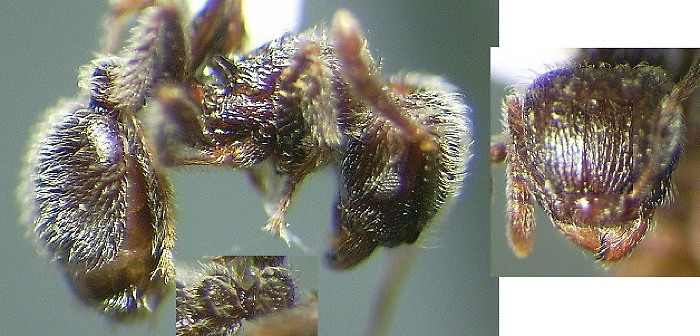 Palp
formula usually 4,3, only very rarely reduced. Head not heart-shaped in
full-face view. Median portion of clypeus without a prominent, arcuate
anterior margin. Antennal scrobes usually, but not always, present.
Ventral margin of petiole not keel-like. Eyes at, or somewhat in front
of, midlength of sides of head. Minute, TL < 2 mm, species with
branched hairs (former Triglyphothrix) and Palp
formula usually 4,3, only very rarely reduced. Head not heart-shaped in
full-face view. Median portion of clypeus without a prominent, arcuate
anterior margin. Antennal scrobes usually, but not always, present.
Ventral margin of petiole not keel-like. Eyes at, or somewhat in front
of, midlength of sides of head. Minute, TL < 2 mm, species with
branched hairs (former Triglyphothrix) and |
. |
| . |
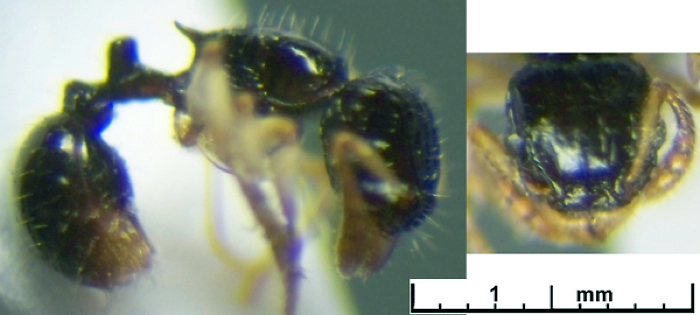 small species
without branched hairs (former Xiphomyrmex). small species
without branched hairs (former Xiphomyrmex). |
Tetramorium (part) |
| Antennae with 12 segments | - | |
| 35 | Dorsum of petiole node at least bidentate, some armed with a pair of sharp spines. | 36 |
| -- | Dorsum of petiole node unarmed or indented medially, lacking sharp spines. | 38 |
| 36 | 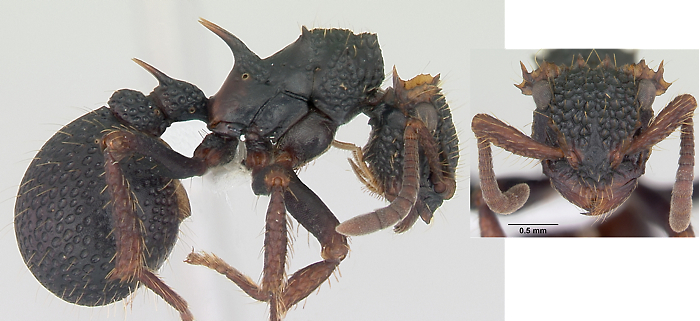 All
of visible portion of gaster consisting of the first tergite, which is
massively enlarged and subglobose, ball-like but with an anteroventral
orifice within which the remaining gastral segments are telescoped.
Eyes at extreme posterior corners of head. Clypeus projecting far
forward and almost concealing the mandibles. Monotypic, large, TL ca
6.5 mm, and arboreal. All
of visible portion of gaster consisting of the first tergite, which is
massively enlarged and subglobose, ball-like but with an anteroventral
orifice within which the remaining gastral segments are telescoped.
Eyes at extreme posterior corners of head. Clypeus projecting far
forward and almost concealing the mandibles. Monotypic, large, TL ca
6.5 mm, and arboreal. |
Ankylomyrma |
| -- | Gaster composed of 4 visible tergites and sternites which decrease in size posteriorly, the gaster with the first tergite not massively enlarged and ball-like. Eyes not at extreme posterior corners of head. Clypeus not projecting far forward over the mandibles. | 37 |
| 37 | 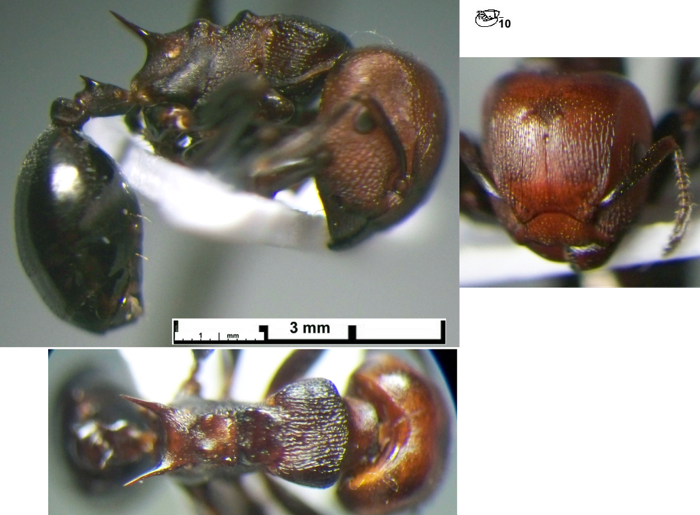 Occipital corners of head
evenly broadly rounded in full-face view. Ventral surface of alitrunk
with a very deep, broad pit between the hind coxae. Ventral margin of
sides of metapleuron eroded in front of the metapleural gland bulla.
Polymorphic species, the propodeum armed with a pair of long spines;
large, TL up to 9 mm; arboreal. Occipital corners of head
evenly broadly rounded in full-face view. Ventral surface of alitrunk
with a very deep, broad pit between the hind coxae. Ventral margin of
sides of metapleuron eroded in front of the metapleural gland bulla.
Polymorphic species, the propodeum armed with a pair of long spines;
large, TL up to 9 mm; arboreal. |
Atopomyrmex (part) |
| -- | 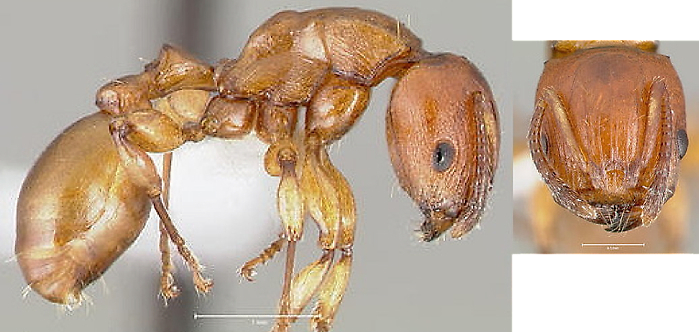 Occipital corners of head
angulate to denticulate in full-face view. Ventral surface of alitrunk
without a deep, broad pit between the hind coxae. Ventral margin of
sides of metapleuron not eroded in front of metapleural gland bulla but
with a conspicuous, broad groove running forward to the mesopleuron.
Monomorphic, medium to small species, TL from 4-6 mm; all arboreal. Occipital corners of head
angulate to denticulate in full-face view. Ventral surface of alitrunk
without a deep, broad pit between the hind coxae. Ventral margin of
sides of metapleuron not eroded in front of metapleural gland bulla but
with a conspicuous, broad groove running forward to the mesopleuron.
Monomorphic, medium to small species, TL from 4-6 mm; all arboreal. |
Terataner |
| 38 | 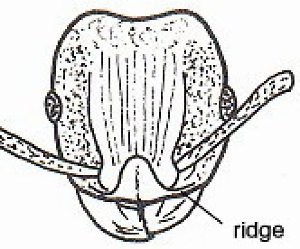 Lateral
portions of clypeus raised up into a sharp-edged ridge or shield wall
in front of the antennal insertions. Lateral
portions of clypeus raised up into a sharp-edged ridge or shield wall
in front of the antennal insertions. |
39 |
| -- | Lateral portions of clypeus not raised up into a sharp-edged ridge or shield wall in front of the antennal insertions. | 40 |
| 39 |  Head heart-shaped in
full-face view. Ventral margin of petiole convex and keel-like.
Anterior clypeal margin strongly arcuate and prominent. Eyes behind
midlength of sides of head and propodeum unarmed. Small, TL ca 3 mm,
species, soil-inhabiting but found on plants tending homoptera. Head heart-shaped in
full-face view. Ventral margin of petiole convex and keel-like.
Anterior clypeal margin strongly arcuate and prominent. Eyes behind
midlength of sides of head and propodeum unarmed. Small, TL ca 3 mm,
species, soil-inhabiting but found on plants tending homoptera. |
Rhoptromyrmex (part) |
| -- | 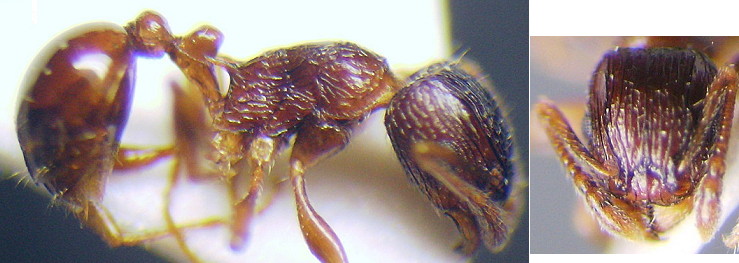 Head
not heart-shaped in full-face view. Ventral margin of petiole never
convex and keel-like. Anterior clypeal margin not strongly convex nor
prominent. Eyes only rarely behind midlength of sides of head and
propodeum usually armed with a pair of spines or teeth. Small, TL 3-5
mm, species with branched hairs (among former Triglyphothrix);
and many species with simple hairs, almost all small. Head
not heart-shaped in full-face view. Ventral margin of petiole never
convex and keel-like. Anterior clypeal margin not strongly convex nor
prominent. Eyes only rarely behind midlength of sides of head and
propodeum usually armed with a pair of spines or teeth. Small, TL 3-5
mm, species with branched hairs (among former Triglyphothrix);
and many species with simple hairs, almost all small. |
Tetramorium (part) |
| 40 | 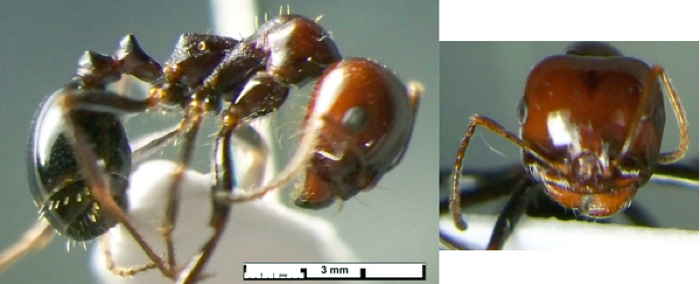 Ventral surface of head with a
psammophore. Head massive and broad, CI > 90. Mandibles massive,
their outer margins strongly curved toward the midline; sometimes
edentate. Metasternal process large or very large, conspicuous.
Polymorphic species, TL 4-12 mm; soil nesting in savannah; primarily
seed-gathering Ventral surface of head with a
psammophore. Head massive and broad, CI > 90. Mandibles massive,
their outer margins strongly curved toward the midline; sometimes
edentate. Metasternal process large or very large, conspicuous.
Polymorphic species, TL 4-12 mm; soil nesting in savannah; primarily
seed-gathering |
Messor |
| -- | Ventral surface of head without a psammophore. | 41 |
| 41 | 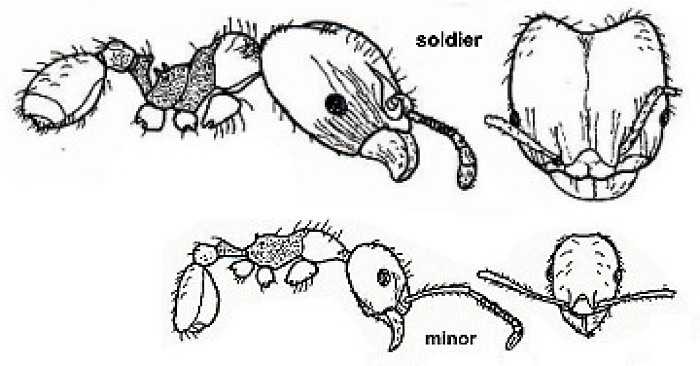 Dimorphic,
with distinctive big-headed soldier morph. Soldiers with mandibles
powerfully constructed, armed with 2 large apical teeth followed by a
long diastema and then 1 or 2 (rarely 3) basal teeth. Two to 4
hypostomal teeth usually present on posterior margin of buccal cavity.
Palp formula 2,2 or 3,2 and clypeus lacking a long, unpaired median
seta on the anterior margin. Minor with moderately elongated triangular
mandibles, with apical large tooth and a series of small teeth ot
denticles. Numerous species mostly small to minute; in most habitats. Dimorphic,
with distinctive big-headed soldier morph. Soldiers with mandibles
powerfully constructed, armed with 2 large apical teeth followed by a
long diastema and then 1 or 2 (rarely 3) basal teeth. Two to 4
hypostomal teeth usually present on posterior margin of buccal cavity.
Palp formula 2,2 or 3,2 and clypeus lacking a long, unpaired median
seta on the anterior margin. Minor with moderately elongated triangular
mandibles, with apical large tooth and a series of small teeth ot
denticles. Numerous species mostly small to minute; in most habitats. |
Pheidole |
| -- | Mandible delicately constructed, armed with 3-5 teeth, serially dentate and decreasing in size from apex to base, not arranged as above. Hypostomal teeth absent from posterior margin of buccal cavity. If palp formula 2,2 then clypeus with a long, unpaired median seta on the anterior margin. | 42 |
| 42 |  Antennal scapes long,
easily surpassing occipital border; face more or less ovoid, clypeus
convex, without carinae, anterior border with median notch; frontal
carinae short, no scrobes; eyes prominent and convex set about
mid-point of face; propodeum with long narrow (occasionally reduced);
abundant long erect hairs. Former Macromischoides, three
species all arboreal and small. Antennal scapes long,
easily surpassing occipital border; face more or less ovoid, clypeus
convex, without carinae, anterior border with median notch; frontal
carinae short, no scrobes; eyes prominent and convex set about
mid-point of face; propodeum with long narrow (occasionally reduced);
abundant long erect hairs. Former Macromischoides, three
species all arboreal and small. |
Tetramorium (part) |
| -- | Antennal scapes not surpassing occipital border; face generally rectangular. | 43 |
| 43 | 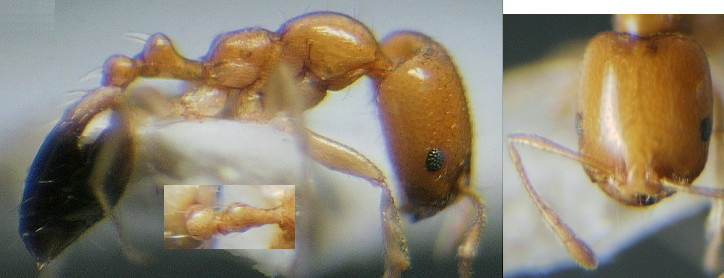 Midpoint
of anterior clypeal
margin with a single, elongate seta, which projects forward over the
mandibles and is usually very conspicuous. Median portion of clypeus
concave to prominent anteriorly, usually overhanging the mandibles,
weakly to acutely bicarinate; lateral portions of clypeus not expanded
forward nor fused with the median portion to form a broad, projecting
shelf; maxillary palps usually with 1 or 2 segments, rarely more;
mandible with 3-5 teeth (usually 4); eyes usually quite small, flat and
set forward of midline of face; propodeum usually unarmed, rarely
angulate or bidenticulate. All small to minute; found in almost all
habitats. Midpoint
of anterior clypeal
margin with a single, elongate seta, which projects forward over the
mandibles and is usually very conspicuous. Median portion of clypeus
concave to prominent anteriorly, usually overhanging the mandibles,
weakly to acutely bicarinate; lateral portions of clypeus not expanded
forward nor fused with the median portion to form a broad, projecting
shelf; maxillary palps usually with 1 or 2 segments, rarely more;
mandible with 3-5 teeth (usually 4); eyes usually quite small, flat and
set forward of midline of face; propodeum usually unarmed, rarely
angulate or bidenticulate. All small to minute; found in almost all
habitats. |
Monomorium
(part) key includes Trichomyrmex and Syllophopsis |
| -- | 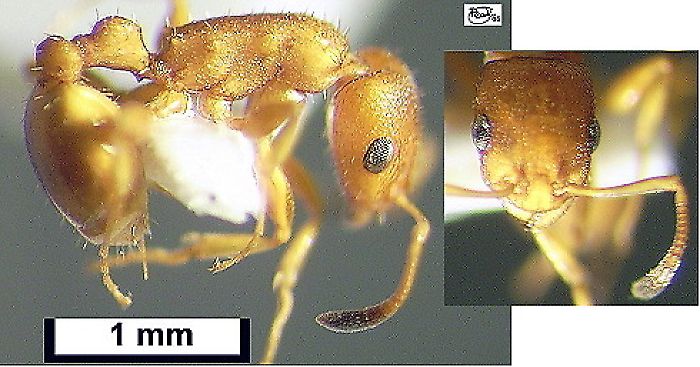 Midpoint of anterior
clypeal margin without a single, elongate seta; instead usually with a
pair of short setae, one on each side of the midpoint With the alitrunk
in profile the mesonotum following the line of the pronotum, not
suddenly and steeply raised above the level of the pronotum; mesonotum
without a near-vertical, somewhat concave free anterior face; dorsum
with short stout erect hairs. All arboreal and small. Midpoint of anterior
clypeal margin without a single, elongate seta; instead usually with a
pair of short setae, one on each side of the midpoint With the alitrunk
in profile the mesonotum following the line of the pronotum, not
suddenly and steeply raised above the level of the pronotum; mesonotum
without a near-vertical, somewhat concave free anterior face; dorsum
with short stout erect hairs. All arboreal and small. |
Nesomyrmex (part) |
| -- | 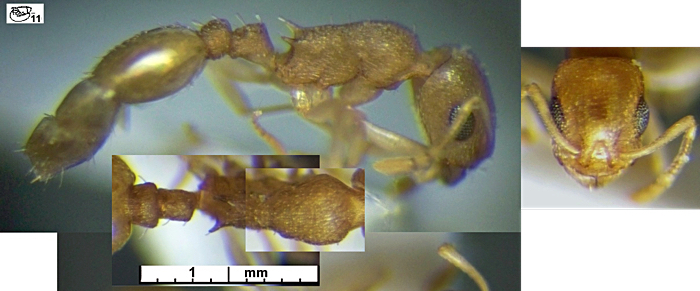 Median anterior
portion of clypeus without a prominent
lobe and not overlapping mandibles; transverse crest absent from stipe
of maxilla; clypeus with median carina Median anterior
portion of clypeus without a prominent
lobe and not overlapping mandibles; transverse crest absent from stipe
of maxilla; clypeus with median carina |
Temnothorax |
|
© 2007, 2008, 2009, 2013, 2015, 2016 - Brian Taylor CBiol FRSB FRES 11, Grazingfield, Wilford, Nottingham, NG11 7FN, U.K. |
href="myrmicinae.htm"